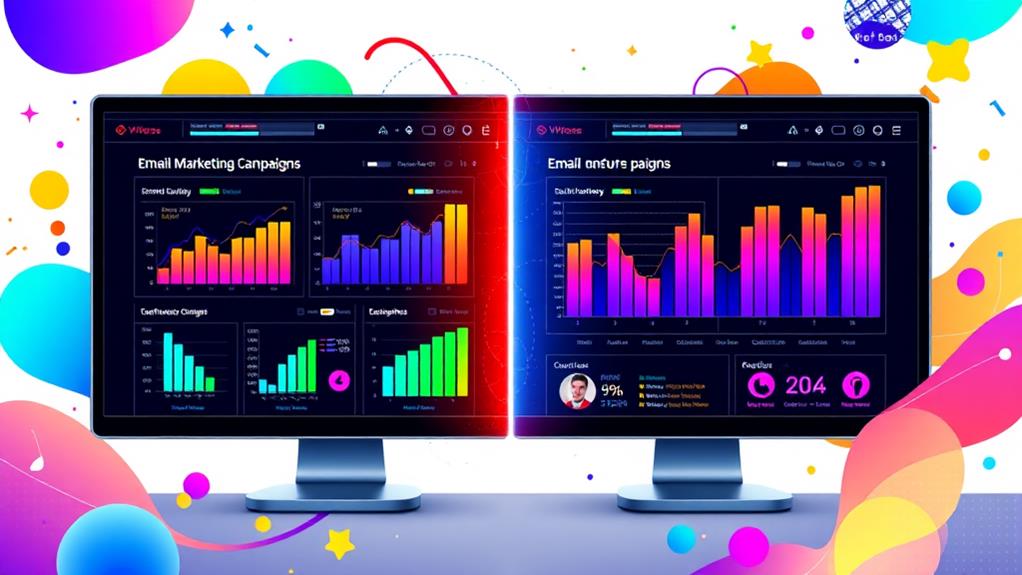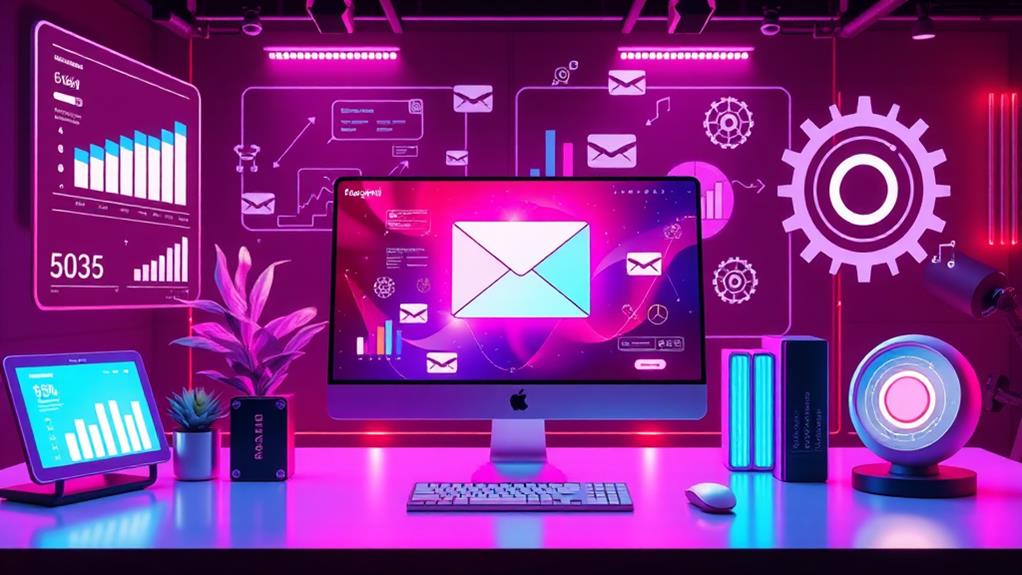To create an automated email campaign that feels human, focus on personalization, segmentation, and dynamic content. Start by using data-driven personalization techniques, like customized subject lines and bespoke recommendations based on user behavior. Effective segmentation enhances open rates, guaranteeing each audience group receives relevant content. Craft emails with a conversational tone, incorporating storytelling and emotional elements to establish a human connection. Leverage trigger-based emails for timely engagement, continuously optimizing with A/B testing to enhance impact. Integrating CRM systems guarantees that communications feel personal and current. Explore these strategies further to boost your campaign's authenticity and engagement potential.
Key Takeaways
- Personalize emails using dynamic content and user behavior to enhance relevance and engagement.
- Utilize a conversational tone and storytelling techniques to create a human-like connection.
- Segment email lists based on demographics and behavior for targeted, effective communication.
- Implement trigger-based emails for timely responses to user actions, boosting engagement.
- Continuously optimize through A/B testing to refine strategies based on engagement metrics.
Understanding Marketing Automation
Marketing automation has become an indispensable tool in the modern marketer's arsenal, transforming how businesses engage with their audiences through email campaigns. By leveraging software to automate workflows, companies can tailor each interaction to the unique stages of a customer's journey, utilizing behavioral insights to enhance relevance and connection. This approach not only streamlines communication but also guarantees that messages resonate with recipients, fostering deeper engagement.
Approximately 50% of companies have recognized the power of marketing automation, adopting these tools to refine their email strategies. A central feature is the use of drip campaigns, which deliver a series of carefully timed emails designed to nurture leads and maintain ongoing engagement. By automating these communications, marketers can focus on crafting compelling content rather than managing logistics.
Moreover, continuous monitoring and A/B testing are critical to understanding and optimizing the customer journey. By analyzing interaction patterns, marketers can identify preferences and tailor future campaigns for maximum impact.
Integrating customer relationship management (CRM) systems further enriches this process, providing real-time updates that allow for dynamic adjustments. Embracing marketing automation ultimately empowers businesses to deliver personalized experiences that align with customer expectations.
Effective Segmentation Techniques
Effective segmentation techniques are crucial for maximizing the impact of automated email campaigns. By employing demographic analysis and behavior tracking, marketers can strategically group subscribers based on shared characteristics such as age, location, or purchasing habits. This targeted approach not only reduces unsubscribe rates but also enhances engagement by guaranteeing content relevance.
Advanced segmentation goes beyond basic demographics. It includes identifying preferred email devices or monitoring specific behaviors, which leads to higher open and click-through rates. When emails resonate with the audience, they are more likely to engage, giving marketers the opportunity to foster deeper connections with subscribers.
Approximately 50% of companies already leverage segmentation in their email marketing efforts, underscoring its essential role in maintaining subscriber engagement and improving overall campaign effectiveness. By tailoring campaigns, whether by sending distinct content to new subscribers versus long-term customers, marketers can considerably enhance the customer experience.
To sustain this relevance, it is critical to regularly analyze and adjust segmentation criteria based on performance metrics. This continuous refinement guarantees that email content remains engaging, ultimately leading to increased customer satisfaction and loyalty.
Implementing these effective segmentation techniques can raise automated email campaigns to new heights, making them both strategic and human.
Personalization for Impact
Personalization is a powerful tool that can dramatically enhance the effectiveness of automated email campaigns. By using techniques such as inserting the recipient's name in subject lines, open rates can soar by up to 22.2%. This form of tailored messaging not only captures attention but also fosters recipient engagement. When emails feel customized, they become more relatable and impactful.
A strategic approach to personalization involves leveraging past purchase data to craft dynamic content. This enhances the relevance of emails by aligning them with the recipient's interests and needs. For example, targeted product recommendations can transform a routine email into an engaging shopping experience. In addition, employing conversational language in the email copy can humanize the interaction, making it feel less automated and more genuine.
To illustrate the power of personalization:
| Personalization Technique | Impact | Example Use Case |
|---|---|---|
| Use of Recipient's Name | Increases open rates by 22.2% | Subject lines |
| Past Purchase Data | Boosts relevance | Product recommendations |
| Dynamic Content | Aligns with user interests | Behavioral triggers |
| Conversational Language | Enhances engagement | Email copy |
| Celebratory Emails | Strengthens brand-subscriber bond | Milestones or special occasions |
Incorporating these methods guarantees that automated email campaigns not only reach inboxes but resonate with individuals, driving both satisfaction and action.
Crafting Human-Like Content
Crafting human-like content in automated email campaigns is essential for fostering genuine connections with recipients. To achieve this, integrate emotionally resonant elements that make the communication feel personal and engaging. Incorporating storytelling techniques can enhance the relatability of your emails and guarantee they resonate on a human level. Consider the following strategies:
- Conversational Tone: Utilize a relatable and conversational tone in your email copy. Research shows personalized subject lines can boost open rates by up to 26%. This approach helps create a more engaging experience, making recipients feel like they're interacting with a real person rather than a machine.
- Personalization Beyond Salutations: Leverage merge fields to infuse your emails with account-specific information. This personalization should reflect users' preferences and behaviors, making the content more relevant and emotionally resonant.
- Storytelling and Humor: Sharing personal anecdotes or stories within your emails fosters a strong human connection. These storytelling techniques remind readers of shared experiences, enhancing relatability.
Additionally, strategically using humor and emojis can lighten the tone and align with your brand voice, preventing communication from feeling overly scripted.
Leveraging Trigger-Based Emails
In the domain of digital marketing, trigger-based emails stand out as a powerful tool for maintaining timely and relevant communication with users. These automated messages, activated by specific user behavior, such as signing up for a newsletter or abandoning a shopping cart, guarantee that brands remain engaged with their audience at critical touchpoints.
By leveraging email triggers, marketers can greatly boost engagement rates, sometimes by as much as 50%, due to the emails' relevance and timeliness.
Implementing a nurturing sequence of trigger-based emails allows brands to guide users through their customer journey with personalized content tailored to their actions. This strategic approach can enhance conversion rates by up to 30%, as customers are more likely to respond to content that resonates with their specific needs and interests.
Additionally, A/B testing different triggers—like inactivity or post-purchase follow-ups—provides valuable insights into user preferences, allowing marketers to refine their strategies based on real user behavior.
Incorporating dynamic content enhances personalization, meeting the expectations of 80% of consumers who prefer tailored experiences. Such timely interventions not only drive engagement but also improve customer retention, recovering up to 10% of lost customers through re-engagement efforts.
Continuous Optimization Strategies
To guarantee your automated email campaigns remain effective and engaging, it is essential to embrace continuous optimization strategies.
Begin by regularly conducting A/B tests on various elements such as subject lines and send times, aiming for a measurable uplift in engagement metrics.
Analyzing these metrics and refining your content dynamically based on customer interactions will help tailor your messaging more precisely, making certain your campaigns resonate well with your audience.
Embrace A/B Testing
A/B testing's transformative power cannot be overstated when it comes to optimizing automated email campaigns. By implementing A/B testing strategies, marketers can explore email component experimentation, comparing different versions to pinpoint which elements—be it subject lines, layouts, or calls-to-action (CTAs)—drive the highest engagement and conversions.
Studies reveal that segmented A/B testing can enhance click-through rates by as much as 49%, underscoring its importance. Here's how to leverage this approach effectively:
- Experiment with Components: Test various subject lines, email designs, and CTAs. This helps determine what resonates best with your audience, thereby enhancing the subscriber experience.
- Data-Driven Decisions: Regularly analyze patterns and preferences revealed through A/B tests, allowing you to make informed decisions that refine your email strategies and improve performance metrics.
- Boost ROI: Companies that employ A/B testing report significant ROI improvements, with 60% of marketers experiencing revenue boosts from refined content and targeting.
Continuous optimization through A/B testing not only helps maintain relevance in an ever-evolving market but also guarantees that automated emails remain engaging and aligned with subscriber interests.
This strategic approach is crucial for fostering long-term customer retention and success.
Analyze Engagement Metrics
Understanding and analyzing engagement metrics is essential for the success of automated email campaigns, as these insights allow marketers to make data-driven adjustments that enhance performance. By consistently monitoring key metrics such as open rates, click-through rates, and conversion rates, marketers can identify engagement trends and uncover significant behavior insights that inform strategic campaign decisions.
Implementing A/B testing on elements like subject lines and call-to-action buttons further refines these insights by revealing which variations resonate most effectively with your audience. This iterative approach allows for continuous improvement, leading to enhanced engagement over time.
Additionally, segmenting your audience based on these metrics enables the delivery of tailored content that feels more relevant and personalized, enhancing the overall user experience.
Automation tools play an important role in this process by tracking the timing and frequency of email sends. Adjusting these elements based on engagement data guarantees ideal delivery times, consequently boosting open and click rates.
Refine Content Dynamically
Successful automated email campaigns thrive on the art of dynamic content refinement, where continuous optimization strategies are paramount. By constantly analyzing key performance metrics, marketers can identify opportunities for improvement and adapt their strategies to better align with user behavior. This dynamic approach guarantees that emails remain relevant and engaging, ultimately leading to enhanced customer satisfaction and campaign success.
To achieve this, consider the following strategies:
- A/B Testing: Regularly test different elements, such as subject lines and email copy, to determine which versions resonate more effectively with your audience. This iterative process helps refine content to better meet subscriber preferences.
- Personalization through Dynamic Content: Leverage user behavior data, like past purchases or browsing history, to tailor emails to individual subscribers. This level of personalization fosters a deeper connection and keeps content engaging and pertinent.
- Feedback Loops: Implement surveys or encourage direct responses to gather insights into customer preferences. This feedback is invaluable for continuously refining content strategies to meet evolving audience needs.
Regularly updating and segmenting email lists based on engagement guarantees that targeted messages reach the most receptive audiences, enhancing overall campaign effectiveness.
Embrace these strategies to maintain a human touch in automated campaigns, driving sustainable growth and loyalty.
Integrating Tools for Success
Integrating the right tools is essential for creating a successful automated email campaign, as it guarantees seamless data sharing and real-time synchronization across platforms.
By connecting CRM systems like Salesforce with email marketing solutions, businesses can enhance customer relationship management and deliver personalized communication effortlessly.
Additionally, leveraging automation tools such as Zapier for custom integrations can trigger timely campaigns based on user actions, optimizing engagement and driving meaningful interactions.
Seamless Tool Integration
In the ever-evolving landscape of digital marketing, seamless tool integration is paramount for achieving efficiency and precision in automated email campaigns. The ability to connect diverse platforms, such as CRM systems with email marketing tools, presents both integration challenges and significant opportunities. These challenges often arise from compatibility issues and data synchronization complexities. However, when compared to the traditional siloed approach, the benefits of seamless integration are undeniable.
- Enhanced Customer Relationship Management: By integrating email platforms with CRM systems, marketers can achieve real-time updates and personalized communication, fostering stronger customer relationships.
- Automated Workflow Optimization: Tools like Zapier automate workflows, ensuring data flows smoothly between applications and reducing manual entry errors, thereby saving valuable time and resources.
- Insight-Driven Engagement: Integrating e-commerce platforms with email services provides deep insights from purchase histories, enabling tailored recommendations that boost customer engagement and drive sales.
Comprehensive integration capabilities streamline processes such as tracking user engagement, managing subscriptions, and sending targeted follow-ups.
In addition, effective integration empowers marketers with automated alerts for specific user actions, like downloads or abandoned carts, allowing for timely follow-ups that enhance satisfaction and retention.
Embracing seamless tool integration is essential for creating email campaigns that not only feel human but are also profoundly impactful.
Real-Time Data Sync
A robust real-time data sync is a cornerstone of effective automated email campaigns, offering unparalleled precision and immediacy in customer interactions. By integrating CRM systems and automation platforms, businesses guarantee customer information is always current, enhancing the personalization and relevance of each communication.
The data synchronization benefits are vast, providing the groundwork for immediate response strategies that react swiftly to customer actions—like sending timely follow-up emails post-purchase or reminders for abandoned carts.
Utilizing APIs and tools such as Zapier empowers marketers to seamlessly connect diverse applications, facilitating smooth data transfer and minimizing the errors associated with manual data entry. This streamlined process not only boosts campaign efficiency but also allows for real-time analytics that offer valuable insights into customer behavior and preferences.
Such insights are essential for refining email strategies, enabling marketers to tailor content dynamically based on evolving trends.
Moreover, consistent synchronization between sales and marketing systems nurtures a cohesive approach to customer engagement, greatly enhancing the overall customer experience. This unified strategy not only raises retention rates but also guarantees that every interaction feels personal and meticulously crafted, ultimately fostering stronger customer relationships.
Frequently Asked Questions
How Do You Make an Email Feel Personal?
To make an email feel personal, employ personalization strategies such as using recipients' names and dynamic content. Foster an emotional connection through conversational language, warm tone, and two-way communication, ensuring recipients feel genuinely valued and engaged.
How Do I Automate an Email Campaign?
To automate an email campaign effectively, utilize email marketing platforms to segment audiences, design targeted workflows, and personalize content. Leverage campaign automation for optimizing timing and messaging, ensuring increased engagement and conversion through data-driven strategies and A/B testing insights.
How to Write an Email Like a Normal Person?
To write an email like a normal person, employ a conversational language and an engaging email tone. Use first-person expressions, personalize content with names, and incorporate humor or anecdotes to foster a genuine connection with recipients.
What Is the Human Touch in Email?
The human touch in email involves fostering an emotional connection through an authentic voice. This approach enhances engagement by personalizing content, encouraging dialogue, and sharing relatable experiences, ultimately making recipients feel valued and connected to the brand.
Conclusion
The creation of an automated email campaign that resonates with human touch requires an extensive understanding of marketing automation and effective segmentation techniques. Personalization enhances impact, while crafting content that mimics human interaction fosters engagement. Trigger-based emails play a vital role in timely communication, and continuous optimization strategies guarantee sustained effectiveness. Integrating the right tools is fundamental for success, enabling a seamless and responsive campaign that meets the dynamic needs of modern consumers in a competitive market.




